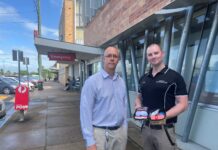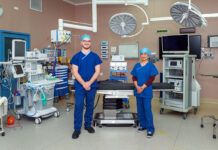
Bundaberg Hospital has introduced a new imaging technique to improve diagnosis of stroke, improve patient outcomes and extend the range of treatment options.
The Wide Bay region has among the highest rates in Australia of stroke, which occurs when blood supply to the brain is cut off.
Perfusion studies using CT scanners are now enabling Wide Bay Hospital and Health Service clinicians to better identify the extent of recoverable brain tissue following an acute ischaemic stroke, as well as the best treatment option.
This can now include highly specialised clot retrieval treatment at the Royal Brisbane and Women’s Hospital (RBWH).
This gives patients a better chance to recover with more brain function and resume their normal life.
In good news that coincides with National Stroke Week, the first Wide Bay patient to benefit from having a clot removed following a CT perfusion is now back at home and recovering.
“For people who have a stroke, the response and treatment of their condition is time critical, which is why our team’s implementation of CT perfusion is such a great step for improving outcomes for our patients,” health service chief executive Adrian Pennington said.
“This technology enables our clinicians to diagnose the patient’s condition quickly and be better informed about what impact that stroke is having, which in turn helps them to make good decisions about their treatment.
“It gives our teams accurate and timely information that enables them to determine when clot removal procedures are appropriate to save brain function and provide that patient to with a better quality of life post stroke.
“We know stroke is a significant issue in our region, and I’m proud that we’re taking steps – in partnership with our colleagues at RBWH – to improve the care for people experiencing what can be a life-changing event.”
Bundaberg Hospital Director of Medical Imaging Michael Samuel said the key to implementing CT perfusion was the development of new software that provided quick and accurate analysis of CT images.
“The images not only show the size and location of the clot but also give our teams detailed information on delivery of blood or blood flow, so that damaged and recoverable areas of the brain can be more accurately measured and quantified,” Mr Samuel said.
“From the detailed information we gain from CT perfusion, our medical imaging team provide clinicians with the knowledge they need to make the best decision for the patient to aid their recovery and rehabilitation from a stroke.”
The new technique has coincided with changes this year to Queensland Health stroke guidelines, which have extended the time window for clot removal procedures from seven to 24 hours post stroke, which is especially important for regional patients who need to transfer to Brisbane for surgery.
“The time window is crucial to clot-removal procedures, but patients now have a better opportunity to receive that treatment as our enhanced understanding of stroke and its treatment has enabled clinicians to extend the window to perform the surgery,” Bundaberg Hospital Staff Specialist Physician Dr Dhananjay Parshuramakar said.
“This is vitally important to regional patients because the previous seven-hour window was narrow and we didn’t have the technology to provide the evidence that a clot extraction was the appropriate treatment in time to make the patient transfer to a tertiary hospital.
“CT perfusion provides that accurate information, and whether the procedure is worth undertaking within the timeframe we need to organise patient transfer.”
Mr Pennington said the CT perfusion service was part of a suite of recent measures to improve WBHHS’s stroke treatments and services, and to improve collaborations with tertiary health services such as Metro North HHS for better patient outcomes. This includes:
- The introduction in 2017 of “clot-busting” stroke thrombolysis treatment
- Hosting the Stroke Statewide Clinical Network meeting in Bundaberg later this year
- Hosting a joint workshop with clinicians from Metro North HHS to further improve treatment pathways for regional patients.
Fast facts on stroke
What is a stroke?
A stroke happens when blood supply to the brain is interrupted. Blood may be interrupted or stop moving through an artery, because the artery is blocked (ischaemic stroke) or bursts (haemorrhagic stroke). When brain cells do not get enough oxygen or nutrients, they die.
Facts and figures on stroke
According to the Stroke Foundation:
- Stroke affects more than 56,000 Australians every year.
- Stroke is one of Australia’s biggest killers – more women die from it each year than from breast cancer, and more men die from it each year than prostate cancer.
- The financial cost of stroke in Australia is estimated to be about $5 billion annually.
How do I recognise stroke?
The FAST test is an easy way to recognise and remember the signs of stroke. Using the FAST test involves asking these simple questions:
Face– Check their face. Has their mouth drooped?
Arms– Can they lift both arms?
Speech– Is their speech slurred? Do they understand you?
Time– Time is critical. If you see any of these signs, call 000 straight away.







